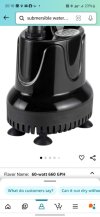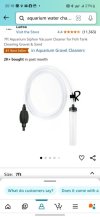Does anyone do auto water changes if so how did you set it up what equipment is used etc.
I don't mean taking out a gallon and replacing it with a gallon. Think something along the lines of 20-25 gallons changed at a time.
By auto I mean a easier way than breaking out buckets and sphion hoses, etc to do it. I'm looking for thoughts or Ideas to make the whole proccess of making salt water and getting it changed easier.
For my 30 gallon tanks I siphon water outta of my 55 gallon rodi storage drum into a 5gallon bucket. I than scoop salt into the bucket and stir the bucket with a long handle spoon. I measure it to ensure salinity matches my tank. Add heater and put a lid on the bucket. The next day I kill the power to all the wave makers, return pumps, and ato. Than I siphon water out of the tank into a matching 5 gallon bucket next to the one with the new saltwater. I stop draining water when the levels of the water in both buckets seem equal. Than I take a 16oz cup and scoop new water back into the tank than I turn the pumps and ato back on after ensuring salinity and water level is correct.
I listed all the steps to show it's managable on smaller tanks. I would definitely like to plan a easier way for this larger tank so it's not a major task that doesn’t take a hour or more.
I wouldn't mind if it involved hoses or pumps I had to break out. Hopefully I wouldn’t have to stir water with a spoon a bucket at a time and hand scoop new water into the tank as not to upset coral by just dumping the bucket into tank.
I'm Looking for a easier way to do this or a way to get it to where I plug something, hit a switch, or just unroll a hose.
I'm open to any suggestions or links to a good videos on the entire proccess or a break down of your setup. I have a extra 55 gallon drum that I intended to use for making salt water but I haven't done anything with it yet.
I do have several extra return pumps that came with the tank so hopefully something can be rigged up, or there is something I can get that will make this easier.
Sorry if this request comes off ad confusing, I would be happy to explain what I'm looking to do better if needed or share pictures of the pumps I have if useful for any of this.
There would also be a 50- 60gallon frag system I would like this to work for as well with a 10-15 gallon water change volume.
I don't mean taking out a gallon and replacing it with a gallon. Think something along the lines of 20-25 gallons changed at a time.
By auto I mean a easier way than breaking out buckets and sphion hoses, etc to do it. I'm looking for thoughts or Ideas to make the whole proccess of making salt water and getting it changed easier.
For my 30 gallon tanks I siphon water outta of my 55 gallon rodi storage drum into a 5gallon bucket. I than scoop salt into the bucket and stir the bucket with a long handle spoon. I measure it to ensure salinity matches my tank. Add heater and put a lid on the bucket. The next day I kill the power to all the wave makers, return pumps, and ato. Than I siphon water out of the tank into a matching 5 gallon bucket next to the one with the new saltwater. I stop draining water when the levels of the water in both buckets seem equal. Than I take a 16oz cup and scoop new water back into the tank than I turn the pumps and ato back on after ensuring salinity and water level is correct.
I listed all the steps to show it's managable on smaller tanks. I would definitely like to plan a easier way for this larger tank so it's not a major task that doesn’t take a hour or more.
I wouldn't mind if it involved hoses or pumps I had to break out. Hopefully I wouldn’t have to stir water with a spoon a bucket at a time and hand scoop new water into the tank as not to upset coral by just dumping the bucket into tank.
I'm Looking for a easier way to do this or a way to get it to where I plug something, hit a switch, or just unroll a hose.
I'm open to any suggestions or links to a good videos on the entire proccess or a break down of your setup. I have a extra 55 gallon drum that I intended to use for making salt water but I haven't done anything with it yet.
I do have several extra return pumps that came with the tank so hopefully something can be rigged up, or there is something I can get that will make this easier.
Sorry if this request comes off ad confusing, I would be happy to explain what I'm looking to do better if needed or share pictures of the pumps I have if useful for any of this.
There would also be a 50- 60gallon frag system I would like this to work for as well with a 10-15 gallon water change volume.
Last edited:


